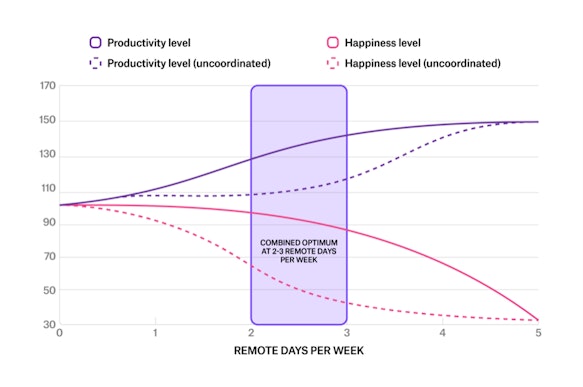Where is the employee ‘sweet spot’ in creating hybrid work model?
Companies experimenting with hybrid models tend to put productivity above all else. A new study suggests happiness, connection and coordinated hybrid work count just as much
As companies everywhere grapple with the realities of hybrid working and experiment with the model that will work best for their business, it’s not uncommon for employers to look at productivity as the key measure of success. But as they focus overwhelmingly on hybrid performance, are they measuring the wrong thing and failing to see the bigger picture?
I ask the question in the light of an interesting research study produced by Christian Wohlrab of Deskbird, a tech start-up founded in 2021 and based in Switzerland and Germany, which has developed a novel office booking and planning tool.
Wohlrab reviewed academic studies in the field and discovered that, according to research, productivity increases the more days that are worked remotely. So, if performance is your only measure, having a fully remote workforce might be the key to success.
Loss of belonging
But when you widen the lens and take other factors into account, such as employee wellbeing and happiness, a different picture emerges. The less you work in the office, the more happiness diminishes and loneliness increases. More remote working days lead to a lessening sense of purpose and belonging, according to published studies. Remote employees lacking close company bonds might easily jump ship to another employer offering more money after a year or two.
So clearly there is a balance to be struck between the demands of the employer for productivity and the needs of the employee for social connection and happiness – which is where the calibration of the hybrid model comes into play, especially in the light of talent retention.
A common formula is to bring employees back to the office two or three days a week, splitting the difference at the roughly the point where productivity increases at the expense of declining individual happiness and connection. However, Deskbird’s research has identified an extra variable: a difference in the productivity drop-off rate in the office according to whether hybrid work is coordinated or uncoordinated.
Coordination helps with morale
Making sure people can plan to meet with the right colleagues and book the right spaces when they come into the workplace – the essence of coordinated hybrid work – helps to slow the drop-off in performance and supports face-to-face collaboration on complex tasks. Effective coordination is also a factor in maintaining employee morale.

Based on his review of academic research, Wohlrab has built a mathematical model to find the ‘sweet spot’ for hybrid working – where the sum of employee productivity and happiness is maximised. This is between two and three days of remote work and requires in-office coordination.
‘Businesses can’t just go hell for leather for productivity, they also need to consider staff happiness’ – Christian Wohlrab
Deskbird claims that implementing this equation can create a productivity gain equivalent to one day per week for every employee. It’s a big claim and one can argue over the precise figures. However, what cannot be disputed is Christian Wohlrab’s underlying point about what companies should be measuring when constructing a hybrid model. As he told me, ‘Businesses can’t just go hell for leather for productivity, they also need to consider staff happiness and retention.’
As the age of experiment in hybrid working gives way to the age of implementation, it’s a point well worth making.
Read more about Deskbird’s analysis here.








